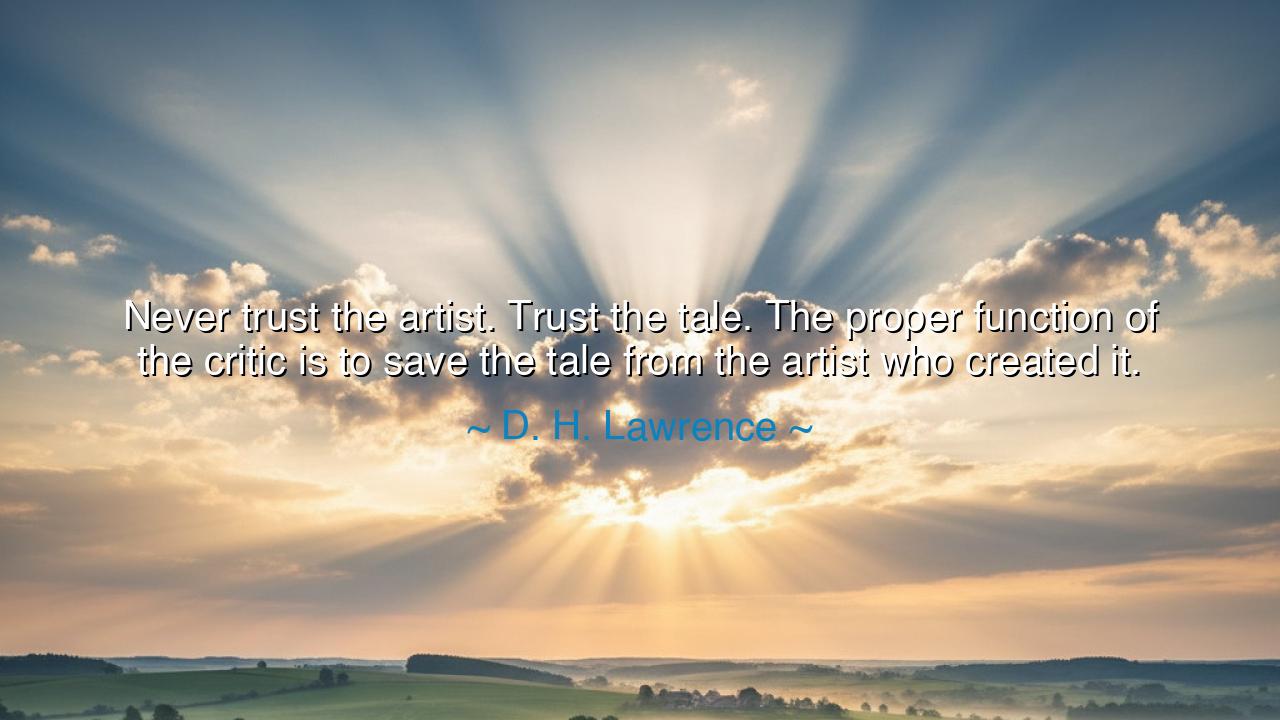
Never trust the artist. Trust the tale. The proper function of
Never trust the artist. Trust the tale. The proper function of the critic is to save the tale from the artist who created it.






“Never trust the artist. Trust the tale. The proper function of the critic is to save the tale from the artist who created it.” Thus spoke D. H. Lawrence, poet of passion and prophet of paradox. His words are not an attack upon creators but a revelation of the mystery of art itself: that once a story, a painting, or a song is born, it no longer belongs to the mind that fashioned it, but to the world. The artist is frail, fallible, and bound by the limitations of his time. But the tale—if true, if beautiful—rises beyond him, carrying a meaning deeper than the artist may ever know.
The ancients glimpsed this truth in their myths. Homer sang of gods and heroes, but who among us can say whether Homer himself believed every word he set down? It matters not. The Iliad endures not because of Homer’s life, but because of Achilles’ wrath, Hector’s courage, and the grief of Priam—all truths of the human soul that outlive the singer. So too Lawrence warns us: do not chain a tale’s power to the imperfection of its maker. Trust the tale, for it carries its own soul, and that soul may be greater than the one who first breathed it into being.
Consider the story of Vincent van Gogh. In life, he was troubled, poor, and unrecognized, scorned even by those around him. Were we to judge his art solely by his tormented existence, we might dismiss his genius as madness. But his paintings speak in colors brighter than sorrow, in visions more eternal than his own despair. The tale outlives the artist. The critic’s task, then, is not to reduce art to biography but to lift the art beyond the shadow of its creator, preserving the flame that the artist himself may have been too weak to tend.
And yet, there is also danger in forgetting this. Too often, men worship the artist as prophet, binding the tale to his personality, his flaws, his sins. This is a grave error. A drunkard may write wisdom, a tyrant may paint beauty, a broken soul may carve eternal truth. If we trust only the artist, we risk throwing away the gift because the vessel was cracked. Lawrence teaches us to look past the hand and see the work, past the voice and hear the song. For the tale, once told, becomes something greater than the one who gave it birth.
History offers us Shakespeare as proof. We know little of the man, and what little we know is ordinary: an actor, a businessman, a man of modest means. But his plays speak with the voice of kings, lovers, clowns, philosophers. The man may have been limited, but the tale was limitless. If we had trusted only Shakespeare’s humble life, would we have believed he could contain Hamlet, Othello, Lear, and Juliet? It is the critic, as Lawrence says, who must “save the tale from the artist,” freeing it from biography so that it may live on as universal truth.
The lesson is clear: honor the tale above the teller. Seek wisdom in the work, not the weaknesses of the worker. Do not discard beauty because its maker was flawed, nor accept falsehood because its maker was celebrated. Be discerning, for art is the child of humanity, but like all children, it may outgrow its parent. The critic’s sacred task—and ours as readers, listeners, and beholders—is to rescue that child, to guard the truth of the tale from the imperfection of the artist.
Practical actions follow. When you encounter art, pause and listen to it as if the artist were a stranger. Ask not, “Who was this person?” but rather, “What does this work reveal to me, to us, to eternity?” Learn to separate the flawed vessel from the eternal flame it carried. And when you create, do not cling too tightly to your own work, for it will belong not to you, but to the world. In this way, we free art from the prison of personality and allow it to stand as a living witness for all generations.
Thus Lawrence’s words, though sharp, carry wisdom eternal: Never trust the artist. Trust the tale. The artist is mortal, but the tale is immortal. The artist is frail, but the tale is strong. The artist may falter, but the tale may save. And so I say to you: treasure the work above the worker, the truth above the teller, and the story above the scribe—for it is the tale, not the artist, that carries the soul of humanity across the ages.






AAdministratorAdministrator
Welcome, honored guests. Please leave a comment, we will respond soon